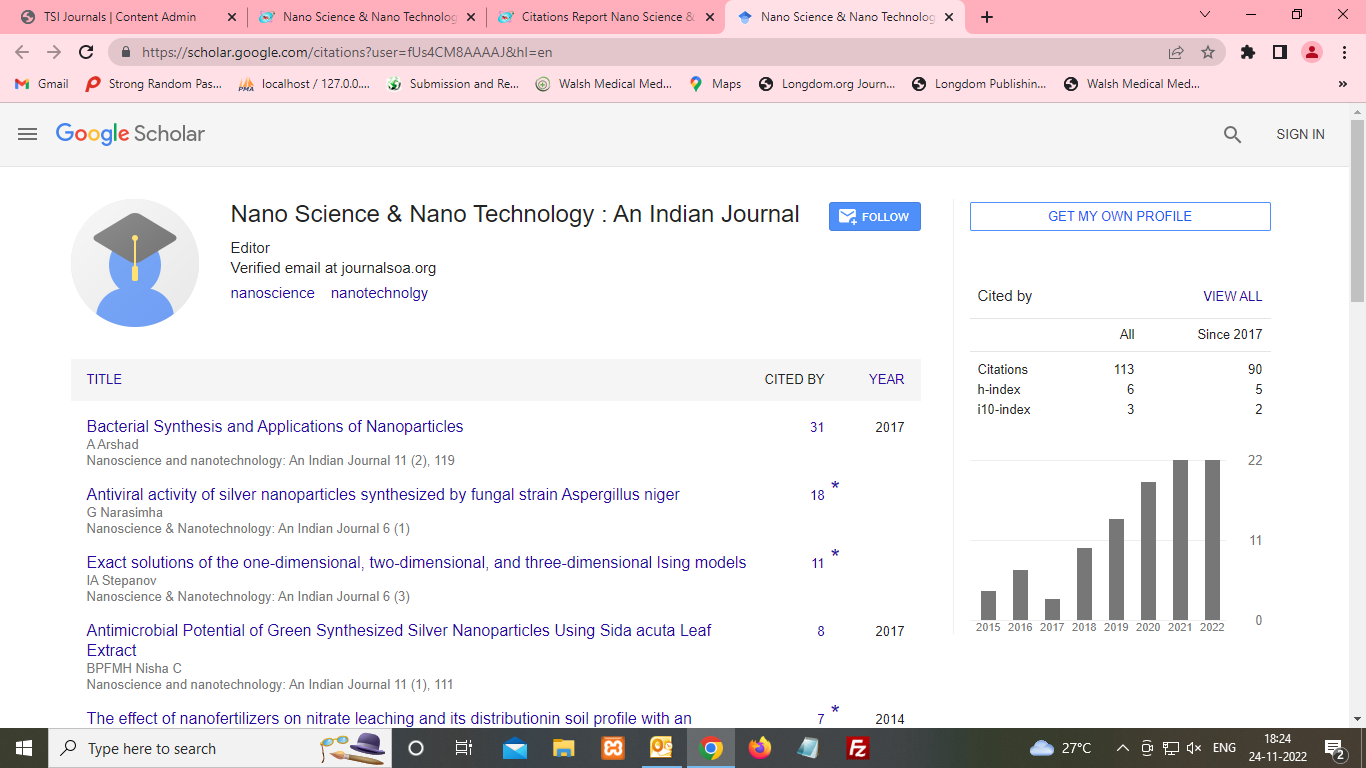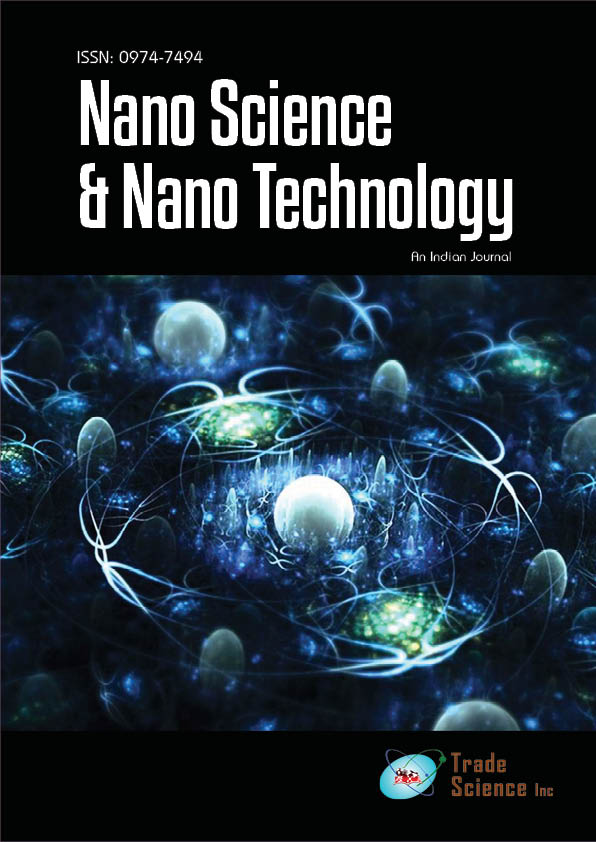Review
, Volume: 16( 6) DOI: doi: 10.37532/0974-7494.2022.16(6).169STUDY OF IR, ESR-SPECTROSCOPY, STRUCTURAL AND BIOLOGICAL PROPERTIES OF 3d METAL ION COMPLEXES WITH GLUTAMINE
- *Correspondence:
- Ganiev Bakhtiyor Bukhara State University, Research laboratory "Chemistry of coordination compounds" named after Academician N.A.Parpiev, Uzbekistan, E-mail:b.ganiyev1990@gmail.com
Received date: 17-October-2022, Manuscript No. tsnsnt-22-77670; Editor assigned: 19-October-2022, tsnsnt-22-77670, PreQC No. tsnsnt-22-77670 (PQ); Reviewed: 22-October-2022, QC No. tsnsnt-22-77670 (Q); Revised: 27-October-2022, Manuscript No. tsnsnt-22-77670 (R); Published: 15-November-2022, doi: 10.37532/0974-7494.2022.16(6).169
Citation: Bakhtiyor G, UM M, JM. Study of IR, ESR-Spectroscopy, Structural and Biological Properties of 3D Metal Ion Complexes with Glutamine Nano Tech Nano Sci Ind J.2022;16(6):169
Abstract
This work presents the results of the study and analysis of the electronic-structural and coordination properties of various forms of glutamine, using quat-chemical calculation, results of synthesis and study of the composition, structure of new single- and multi-ligand mono- and binuclear glutamine complexes of ions of some 3d metals by methods of quantum chemical calculation, IR, ESR spectroscopy and their biological activity
Keywords
Density functional theory; Zwitterion; Molecule; Charge; Structure; Donor-acceptor interaction; Quantum-chemical calculations; Electron-paramagnetic resonance
Introduction
This report presents the results of the synthesis and study of the composition, and structure of new single- and multi-ligand monoand binuclear glutamine complexes of ions of some 3D metals by methods of quantum chemical calculation, IR, ESR spectroscopy, and their biological activity. Based on the data of the study of quantum chemical calculation, the charge distributions on the atoms of the glutamine molecule were determined depending on the pH of the medium and the electron donarity and coordination capabilities of oxygen and nitrogen atoms in the α-amino carboxylate and γ-amide groups were established. Based on the totality of the results obtained and the data of structural studies by other authors, the reason for the participation of the γ-amide group in biochemical processes, amide-imide tautomerism, and the activity of the O, N α-amino carboxylate group atoms in the donor-acceptor interaction with metal ions was clarified.
Taking into account the above, coordination compounds of glutamine with VO2+ ion were synthesized, based on the data of quantum chemical calculation and IR and ESR spectroscopy, the participation of the atom of the N amide group b in intramolecular protonization due to the migration of the H+ ion of the α-COOH group in molecular complexes with VO2+ was established. The same method of coordination of glutamine in molecular and intramolecular complexes through the atoms of the O, N α-amino carboxylate group with the formation of a 5-membered chelate cycle has been proved.
To synthesize and study mixed ligand complexes, new single- [Mn+ (Gln)x] (M–Na+ , Mg2+ , Zn2+ , Cu2+ , Ni2+) and multi–ligand [Cu2 (Gln)2L2 1–3 ] Gln-H2N(O)C(CH
Identification of the complexes was carried out based on diffractograms taken on the XRD-6100 diffractometer (Shimadzu, Japan). The methods of coordination of ligands and the composition and structure of complexes are established according to IR and ESR spectra
The ESR spectra of aqueous solutions of the complexes were recorded at 300 K on a SPINSCAN X radio spectrometer (ADANI, Belarus),in TABLE 1 parameters are mention,while in FIG. 1-3 parameters are shown.
When studying the intramolecular complex of glutamine with copper(II) ions, the g-factor was determined to be 2.062 and 2.037 (TABLES 1 and 2) (FIG. 4). Some papers have predicted that the g-factor varies with donor groups and their coordination. TABLE 2 shows these g-factors of different glutamine complexes.
TABLE 1. ESR parameters of the spectra of complexes I-III
| No | Complex compounds | A , ∈ | g |
|---|---|---|---|
| 1 2 3 4 |
(Cu2Gln2·2Urea)·2L (I) (Cu2Gln2·2Atsetamid)·2L (II) (Cu2Gln2·2Tiourea)·2L (III) (CuGl n2)·2CH3COO (IV) |
55,44 56,24 57,35 90 |
2,1212 2,1210 2,1208 2,0495 |
TABLE 2. ESR parameters of the spectra of copper complexes IV [1-3].
| Literature | In thus work | [1] 9.44 GHz | [2] 9.8 GHz | [2] 33.9 GHz | [3] 33.9 GHz | [5] |
|---|---|---|---|---|---|---|
| g-factor of the copper(II) glutamine complex | 2,062 2,037 | 2,063 2,274 | 2,049 2,248 | 2,053 2,248 | 2,254 2,295 | 2,039 2,217 |
It is concluded that in Na, Mg salts glutamine is in the carboxylate form with the formation of an ionic bond with the α-COOgroup and molecular complexes, the ions Zn2+ , Cu2+, Ni2+ are coordinated by the bidentate-cyclic function of the α-COO- group. In the intra-molecular complex of the copper (II) ion, the glutamine ligand is bidentately coordinated through the N and O atoms of the α-carboxylate group to form a five-membered chelate cycle around the central ion.
Based on the results of studying the IR spectra, a conclusion was made about the internal molecular complex of the glutamine complex of the copper(II) ion (FIG. 5), in which the amino acid anion is connected bidentately through the N and O atoms of the α-hydrocarboxylate group to form a chelate ring around the Cu2+ ion [4 -6].
Based on ESR spectroscopy data, the formation of monomeric (IV) and dimeric complexes (I-III) of copper (II) has been established. It is noted that the formation of dimeric complexes is associated with the participation of L1–3 amide ligands and a monomer complex in the presence of a second carboxylate ligand. Identification of the complexes was carried out based on diffractograms taken on the XRD-6100 diffractometer (FIG. 6 and 7).
In order to identify practical applications, the biological activity of synthesized complexes of the composition [M+n(Gln)xL4 ] (IVVIII) concerning two different pathogenic bacteria Pseudomonas aeruginosa and Candida albicans.
Microorganisms used to study the antibacterial activity of 3d metal glutamine complexes are Pseudomonas aeruginosa and Candida albicans. Pseudomonas aeruginosa causes a wide range of infections in humans, such as urinary tract infections, respiratory system infections, and soft tissue infections. Candida albicans do not cause problems at normal levels, and when it grows out of control, the level of healthy bacteria is minimized; it causes fungal infections in humans. FIG. 8 and 9 shows the inhibitory activity of two different pathogenic bacteria, Pseudomonas aeruginosa and Candida albicans. It was found that some complexes have a higher antagonism to the control, for example, the copper(II) ion complex in both bacteria of the same equal growth of 24 mm-26 mm. And the complex of the cobalt(III) ion is more antagonistically equal to the growth of 36 mm-38 mm/26 mm-28 mm, for chromium(III) the least than the complex of copper(II) is equal to the growth of 13 mm-15 mm/19 mm-20 mm.
It was revealed that free glutamine and complexes of Mn+2, Ni+2 ions did not exhibit antibacterial properties to both types of bacteria. Complexes of Cu2+, Co2+, Cr3+ ions showed antibacterial activity, and copper complexes showed almost the same antagonism against both bacteria, cobalt complexes against Pseudomonas aeruginosa were 1.37 times more active than Candida albicans. Chrome complexes against the bacterium Candida albicans showed activity 1.39 times more than against the bacterium Pseudomonas aeruginosa. In general, according to the antibacterial activity, the complexes, depending on the nature of the complexing agents, were located in the series Co2+>Cu2+>Cr3+ .
REFERENCES
- Deschamps P, Zerrouk N, Nicolis I, et al. Copper (II)–l-glutamine complexation study in solid state and in aqueous solution. Inorganica chimica acta. 2003;353:22-34.
- Schveigkardt JM, Rizzi AC, Piro OE, et al. Structural and Single Crystal EPR Studies of the Complex Copper l?Glutamine: A Weakly Exchange?Coupled System with syn?anti Carboxylate Bridges. European Journal of Inorganic Chemistry.2002(11):2913-9.
- Arena G, Conato C, Contino A, et al. Cu (II)-L-glutamine and L-asparagine binary complexes. A thermodynamic and spectroscopic study. ANNALI DI CHIMICA-ROMA-. 1998;88:1-2.
- Baran EJ, Viera I, Torre MH. Vibrational spectra of the Cu (II) complexes of L-asparagine and L-glutamine. Spectrochimica Acta Part A: Molecular and Biomolecular Spectroscopy.2007;66(1):114-7.
- John L, Joseyphus RS, Dasan A et al. Protein binding and cytotoxicity activities of glutamine based metal complexes. Journal of Molecular Structure. 2021;1240:130540.
- Mardonov UM, Ganiev BSh, et al. Study by methods of quantum-chemical calculation and EPR spectroscopy of electronic-structural and coordination properties of various forms of glutamine. Universum: chemistry and biology. 2022;92:49-54.










